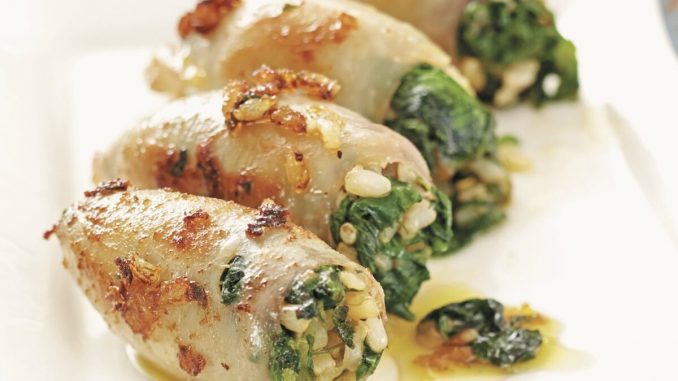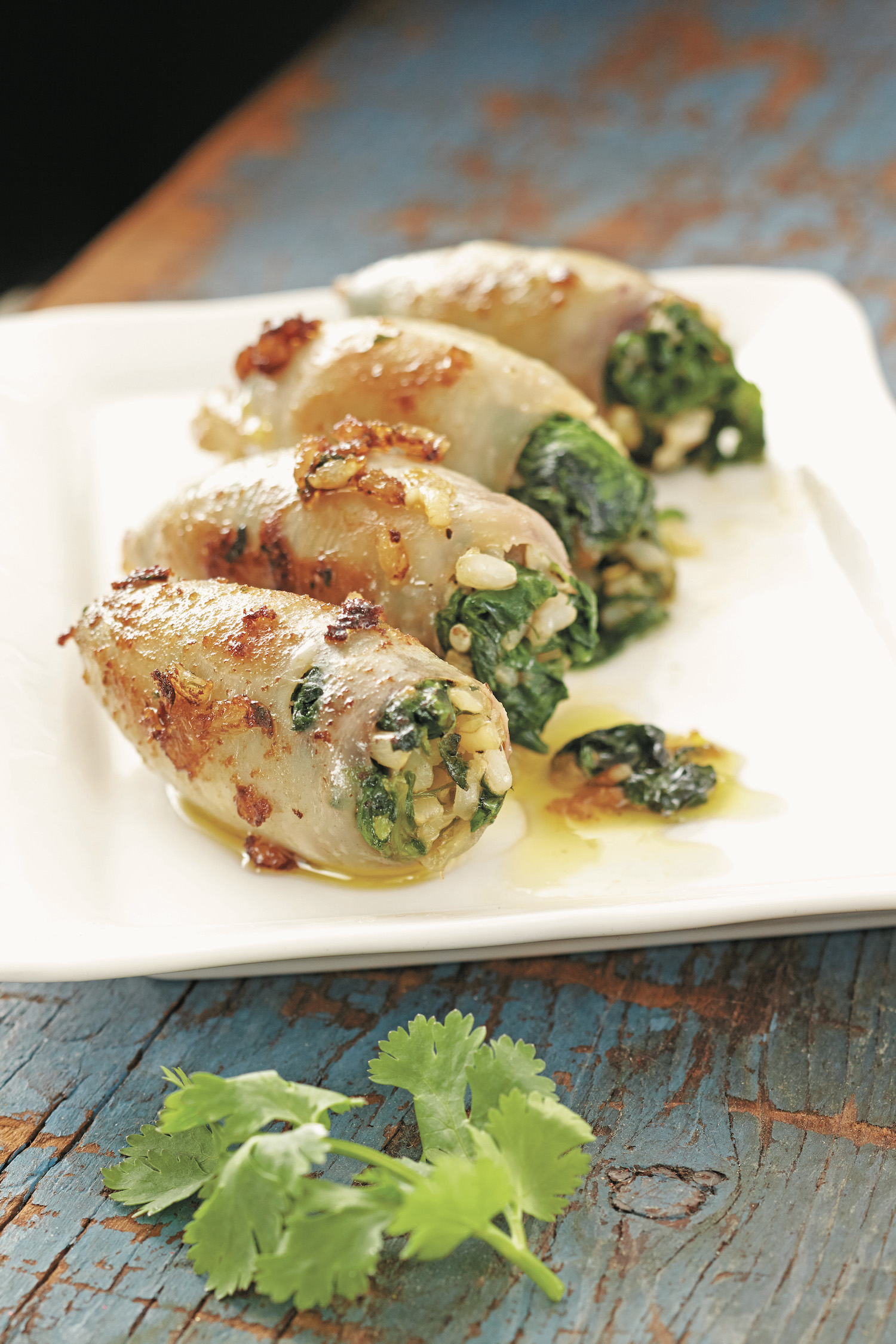
There is a category of recipes that I make that I lovingly refer to as “dream dishes.” Dream dishes, to me, are ones that transport us to another time or place. When we’re really lucky, the mere smell of a certain dish can take our senses on a trip to a dream destination. When I make rice-stuffed calamari, I can’t help but feel like I’m in the Greek islands.
Something about the aroma of the fresh dill and parsley wafting in the air, combined with the feeling of the olive oil and rice between my fingers as I stuff fresh baby squid, makes me feel as if I’m in sunny Santorini or the fabled Ikaria—the Blue Zone island whose healthy citizens seem to “forget to die.” Taking a bite of the finished dish, bright with the flavors of the citrusy herbs and fruity olive oil, I’m immediately transported to the breezy family gatherings of my childhood.
The second reason I consider dishes like this a “dream” to prepare is that they are easy, quick, and fun, but yield impressive results. This recipe can be made in under 25 minutes if you’re totally engaged—I know because I’ve done it on TV several times!
Notes on Squid
When many English-speakers think of squid, we often picture the fried form that is available in many restaurants, and refer to it with the Italian word calamari. The etymology of the word actually comes from the ancient Greek Kalamos, for pen, which the little tubes do resemble, especially with their tentacles attached. When whole, they look like the quills that people used to write with. Eventually the word fused with the modern Italian calamari, and now Greeks use the same word spelled with a “k.”
The Mediterranean diet recommends eating seafood two to three times per week. Squid adds flavor and variety to many pescatarian diets: In addition to frying, many cultures around the Mediterranean roast, braise, and stew squid. It’s also served in famous pasta, risotto, paella, and soup preparations.
Squid is a great seafood choice because of its high vitamin and mineral content. It’s very high in copper, a trace mineral that helps the body with nutrient absorption; and vitamin B2, which helps with pain relief, such as for migraine symptoms. It’s also a great source of complete protein, making it good for burning fat and building muscle. But since squid is one of the varieties of seafood that is high in cholesterol, it’s best to limit consumption to once a week, if you do not have problems with cholesterol.
It’s important to distinguish between full, mature squid, which are quite large, and baby squid. Baby squid are surprisingly simple to prepare, because their small size and more delicate texture help them cook up in just minutes, without becoming rubbery.
A Simple Stuffing
In this dish, baby squid are stuffed with a simple but winning combination of rice, onion, spinach, and fresh herbs. The filling works just as well for stuffing vegetables and grape leaves.
Alongside seafood, dill, parsley, onion, and olive oil are among the most commonly found ingredients in Greek island kitchens. Each of them have been present in the region since antiquity, and spread throughout the Mediterranean region when Greek explorers set up colonies in Southern Italy, France, and into the Eastern Levantine regions.
Spinach is one of the most nutrient-dense vegetables around, so I love sneaking in into recipes whenever possible. In addition to high amounts of iron, spinach also contains a lot of water, so it helps us stay hydrated in warmer weather. Eating spinach also helps to curb our appetites and make us feel fuller, and its high calcium, manganese, and vitamin K content are important for healthy bones and keeping osteoporosis at bay.
If you’re preparing squid for the first time, one of the things that might surprise you is how neutral their flavor is. I like to think of them as blank culinary canvases from the sea. You can season them with your own favorite blends of herbs and spices and try them in different preparations, to enjoy different dream dishes and destinations each time.

Greek Island-Style Stuffed Squid With Rice and Herbs (Yemisto Kalamari me Voutiro)
If you’ve only eaten fried calamari, you’ll love this light, healthful version, with its flavors straight from the Aegean Islands. The tender texture of the baby squid in this unique dish lends itself to a straightforward cooking style. You may also cook full-size squid this way, but you will need to increase the filling quantities and cooking time.
Makes 4 servings
- 2 tablespoons Amy Riolo Selections or other extra-virgin olive oil, divided
- 1 small yellow onion, finely chopped
- 1 pound fresh spinach
- 1/4 cup short grain rice
- 2 tablespoons freshly chopped parsley
- 2 tablespoons freshly chopped dill
- 1 teaspoon unrefined sea salt or salt
- Freshly ground pepper
- Dash of crushed red chile flakes
- 1 pound baby squid, tentacles removed, and cleaned
- 2 cups vegetable or seafood stock
Heat 1 tablespoon of olive oil in a large wide skillet over medium heat. Add the onion and sauté until golden, about 5 minutes.
Add the spinach, rice, parsley, dill, salt, pepper, and red chile flakes and cook for 1 minute. Take the mixture off the heat and allow to cool slightly.
Stuff the baby squid three-quarters of the way full with stuffing. Secure the top with a toothpick, leaving a little bit of room between the toothpick and the top of the stuffing for the rice to expand while cooking.
Heat the remaining olive oil in a large frying pan over medium heat. Brown the squid on all sides.
Add the stock, cover, and simmer on low until cooked through, 15 to 20 minutes, or until the rice is tender to the bite and the squid are cooked through. Serve warm.
Recipe from The Ultimate Mediterranean Diet Cookbook by Amy Riolo. Video on YouTube.
Amy Riolo is an award-winning, best-selling author, chef, TV host, and educator. As a Mediterranean lifestyle ambassador, she is known for sharing history, culture, and nutrition through global cuisine, and simplifying recipes for the home cook. Find her at AmyRiolo.com.





Be the first to comment